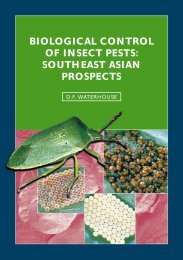You also want an ePaper? Increase the reach of your titles
YUMPU automatically turns print PDFs into web optimized ePapers that Google loves.
Vol. 34, No. 2 Internat. J. Acarol. 153<br />
Fig. 2. Galls per plant (mean values). Bars with the same letter indicate no statistical difference between treatments.<br />
ber of galls per plant showed a positive linear tendency<br />
(R² = 0.969) indicating that the increase in the number of<br />
galls attached to plants resulted in a 96.9% increase in the<br />
number of infested stems: the more infested stems, the<br />
more galls are formed on them.<br />
The conditions under which the experiments were<br />
conducted could have limited the infestations and damage<br />
caused to field bindweed. Hammon (2007) mentioned an<br />
inverse relationship between the amount of irrigated water<br />
applied and the success of infestations. The daily application<br />
to each pot of 320 ml of water and the high humidity<br />
(Table 1) which occurred during the experiments<br />
could have affected the settling success of the mites, negatively.<br />
In these experiments the damage caused by A.<br />
malherbae on the leaves of field bindweed was similar to<br />
the damage observed by McClay et al. (1999) who reported<br />
that over a period of one to four years, A.<br />
malherbae caused light to severe damage to field bindweed<br />
under field conditions.<br />
Another important consideration is that when the<br />
eriophyids are transferred one by one, it is guaranteed that<br />
only A. malherbae is present in the new colony. However,<br />
this method may cause dehydration if the mites are exposed<br />
to direct heat or they may be injured while being<br />
transferred. Also, when transfering by galls it is necessary<br />
to clean the galls to avoid thrips, white flies, or spider<br />
mites. The advantages of using this method are a higher<br />
Fig. 3. Positive linear relationship in the number of galls dependent on the number of infested stems.






